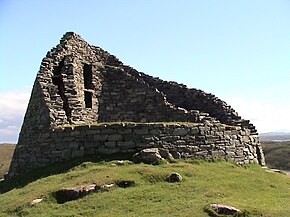Dun Carloway

Dun Carloway
|
|
| Location | Isle of Lewis |
|---|---|
| Coordinates | 58°16′10″N 6°47′39″W / 58.269572°N 6.794104°W |
| Type | Broch |
| History | |
| Periods | Iron Age |
| Site notes | |
| Ownership | Historic Scotland |
| Public access | Yes |
Coordinates: 58°16′10.35″N 6°47′38.47″W / 58.2695417°N 6.7940194°W
Dun Carloway (Scottish Gaelic: Dùn Chàrlabhaigh) is a broch situated in the district of Carloway, on the west coast of the Isle of Lewis, Scotland (grid reference NB18994122). It is a remarkably well preserved broch - on the east side parts of the old wall still reach to 9 metres tall.
Most brochs were built in the period from 100 BC to 100 AD. Dun Carloway was probably built in the 1st century AD. Through the centuries Dun Carloway remained in use until the floor level was too high due to build-up of the occupation layers.
The broch was occasionally used in later times as a stronghold. The Morrisons of Ness put Dun Carloway into use in 1601. The story goes that they had stolen cattle from the MacAuleys of Uig. The MacAuleys wanted their cattle back and found the Morrisons in the broch. One of them, Donald Cam MacAuley, climbed the outer wall using two daggers and managed to smoke out the inhabitants by throwing heather into the broch and then setting fire to it. The MacAuleys then destroyed the broch.
Presumably in the 16th century the walls of the broch was still largely intact. By the middle of the 19th century a large portion of the top of the wall had disappeared, the stones being re-used in other buildings. The situation in 1861 is shown in a drawing published in 1890 by Captain Thomas. To prevent further decay Dun Carloway was in 1882 one of the first officially protected monuments in Scotland. Five years later, the broch was placed under state management. Since then, restoration has been performed on the broch. At the beginning of the 20th century and in the 1970s there was limited archaeological excavation.
...
Wikipedia

